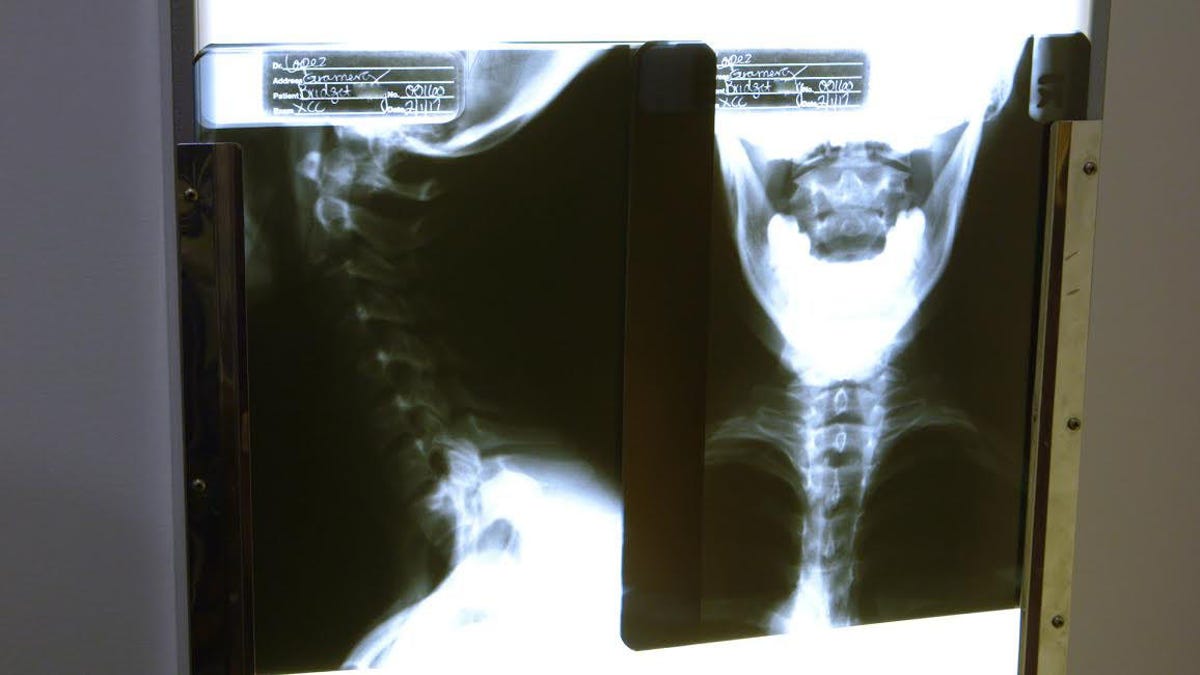It's not too late to stop your phone from wrecking your neck
Bad posture really can mess up your spine. It happened to me, but there are things you can do to prevent the problem and feel better.

This is part of CNET's #adulting series of stories to help you figure out how to live, work and play now that you're all grown up.
There's something personal I need to share. Promise not to laugh?
I have tech neck.
Yeah... I know. The ridiculous-sounding affliction is linked to texting-addicted teenagers. Only, I'm not a teen. I'm a new mom in my 30s. And I didn't believe "tech neck" or "text neck" was a thing that could happen to any reasonable adult -- that is, until an X-ray from my chiropractor proved otherwise.
Years of poor posture while using laptops and cellphones led to a slight change in the curve of my spine. My head is starting to shift forward, ever so slightly. Doctors call this problem forward head carriage, a part of upper crossed syndrome.
If your ears are not lined up with your shoulders, you may have it, too. (Go on, check. I'll wait.)
Your ear is supposed to be in line with your shoulders. My head is more forward than it should be, as demonstrated by chiropractor Dr. Mackenzie Hubert.
X-rays show a change in the curvature of my cervical spine.
How I knew I had tech neck
I initially went to a health professional to address the enduring pain in my upper back (the trapezius muscle), which always flared up after working on the computer. But the diagnosis from my chiropractor went far beyond sore muscles. The bones in my spine are getting denser.
Ever heard of a bone spur? That's what started to happen to me -- but on my vertebrae. Bone spurs can happen when muscles and joints are overburdened, so the body forms more bone to better handle the misplaced weight. In this case, it was the weight of a 10-pound head always leaning forward.
"This doesn't happen over a week or two using a phone -- this is years," as my chiropractor, Dr. Mackenzie Hubert, explained to me.
My case is minor now, but if it gets worse, I'm looking at possible disc degeneration or nerve complications. This doesn't have to be your story, though. You can prevent this by making a few small habit changes.
Text like a T-Rex
You wouldn't put a 60-pound weight on your neck every time you look at your phone -- but that's the force you're putting on your cervical spine when tilting your head down.
The fix: Give your noggin' less reason to tilt by holding your phone like a T-Rex. Keep your elbows to your sides, holding the phone up higher to your face, so you can read it while keeping your head straight.
The human head weighs about 10 pounds. The more you tilt your head forward and down, gravitational forces dramatically increase the weight felt by your neck. So tilting your head 30 degrees is like making your neck lift 40 pounds. A 60-degree tilt is equivalent to 60 pounds of force.
When you look down at a phone, your neck has to work harder to hold up your head. Tilting your head 60 degrees puts 60 pounds of force on the cervical spine.
Dr. Ken Hansraj, a New York back surgeon, calculated the force felt on the cervical spine when texting and looking down, and published his findings in the journal Surgical Technology International. He's currently working on a book about spinal health.
Technology may have increased the frequency of this neck pain, but Dr. Hansraj said simply being more mindful of keeping good posture is a starting point to healing.
"The body changes and the body is very forgiving," said Dr. Hansraj.
Sitting properly at your desk can make a big difference.
Don't be a dope at your desk
Laptops can be terrible for your posture, so it's vital to have a good desk setup to avoid hunching and leaning forward.
The fix: Sit up straight with your feet flat on the floor. (You may need a footrest if your desk height isn't adjustable.)
The top of your monitor should be at your eye level, about an arm's length distance away from you.
Your elbows should be at your sides when typing, wrists flat on the table as you type. You don't want to be reaching far for your mouse.
A proper chair would have armrests hugging your sides, so you don't lean outward to rest your arms.
Ergonomic specialists can assess your office setup and make suggestions for better keyboards and chairs. Ask your human resources department if they offer any help in this area.
Stretching regularly not only relieves the strain on your neck, but you'll look super cool doing it.
Master the stretch
In the end, we all end up leaning and slouching.
The fix: Counter the computer crunched-up strain by stretching in the opposite direction -- bend your head back and look up. Take breaks to do this throughout the day.
It's also helpful to stretch your arms back and squeeze your shoulder blades, along with rolling your shoulders.
If stretching doesn't relieve your discomfort, see your doctor and talk to a specialist. It's what it took for me to finally feel better. I've spent the past four months retraining my body through physical therapy, chiropractic adjustments, as well as taking stretch breaks and being more mindful of my posture.
If you need a catchy way to remember good posture, enjoy this song about tech neck, written for CNET by Dr. Hubert:
#adulting: Check out the rest of CNET's adulting package and learn how you *can* even.
CNET Magazine: Check out a sample of the stories in CNET's newsstand edition.

